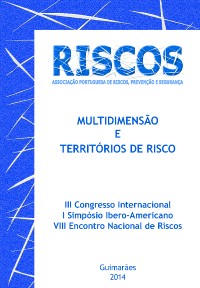Please use this identifier to cite or link to this item:
https://hdl.handle.net/10316.2/34808| DC Field | Value | Language |
|---|---|---|
| dc.contributor.author | Ferreira, Marcos César | |
| dc.contributor.author | Garófalo, Danilo Trovó | |
| dc.contributor.author | Messias, Cassiano | |
| dc.contributor.author | Ferreira, Marta Marujo | |
| dc.date.accessioned | 2014-12-11T16:44:52Z | |
| dc.date.accessioned | 2020-09-09T18:06:16Z | - |
| dc.date.available | 2014-12-11T16:44:52Z | |
| dc.date.available | 2020-09-09T18:06:16Z | - |
| dc.date.issued | 2014 | - |
| dc.identifier.uri | https://hdl.handle.net/10316.2/34808 | - |
| dc.description.abstract | The aim of this paper is to present a spatial decision model based on logistic regression, fuzzy classification and GIS-based techniques, applied to erosion risk mapping. The spatial database was composed by following maps: NDVI vegetation index (1); terrain slope calculated from ASTER-GDEM2 (2); structural lineaments density (3); road density (4) and a map of 729 gullies sites surveyed in the study area (5), obtained by Google images visual analysis and field trip. The values of maps 1 to 4 were classified in 10 classes using the quantil method. Total of gullies occurring in each class was calculated using overlay between one each of the maps 1 to 4, and the map 5. Odd ratios (OR) values indicating the chances in favor of a gully event in relation to the chances against it, in each class map, were estimated using logistic regression. Then, OR curves were converted in fuzzy values using membership functions (Mf). The erosion risk in each pixel was estimated using the weighted sum of the following fuzzified variables: vegetation index, terrain slope, road density and structural lineaments density. | eng |
| dc.language.iso | por | - |
| dc.publisher | Imprensa da Universidade de Coimbra | por |
| dc.publisher | RISCOS - Associação Portuguesa de Riscos, Prevenção e Segurança | por |
| dc.relation.ispartof | http://hdl.handle.net/10316.2/34789 | por |
| dc.rights | open access | - |
| dc.subject | Fuzzy classification | eng |
| dc.subject | GIS | eng |
| dc.subject | risk map | eng |
| dc.subject | risk map | eng |
| dc.subject | logistic regression | eng |
| dc.subject | classificação fuzzy | por |
| dc.subject | SIG | por |
| dc.subject | mapa de riscos | por |
| dc.subject | ravinas | por |
| dc.subject | regressão logística | por |
| dc.title | Um modelo espacial baseado em método de classificação fuzzy, aplicado ao mapeamento de risco à erosão | por |
| dc.type | bookPart | por |
| uc.publication.firstPage | 95 | - |
| uc.publication.lastPage | 100 | - |
| uc.publication.location | Coimbra | por |
| dc.identifier.doi | 10.14195/978-989-96253-3-4_16 | - |
| dc.identifier.doi | 978-989-96253-3-4 (PDF) | - |
| uc.publication.section | Capitulo 2 - Geotecnologias aplicadas à análise e gestão de riscos | por |
| uc.publication.digCollection | PB | por |
| uc.publication.orderno | 16 | - |
| uc.publication.area | Ciências Sociais | por |
| uc.publication.bookTitle | Multidimensão e territórios de risco | - |
| uc.publication.manifest | https://dl.uc.pt/json/iiif/10316.2/34808/210355/manifest?manifest=/json/iiif/10316.2/34808/210355/manifest | - |
| uc.publication.thumbnail | https://dl.uc.pt/retrieve/11164354 | - |
| uc.publication.parentItemId | 53875 | - |
| uc.itemId | 70089 | - |
| item.grantfulltext | open | - |
| item.fulltext | With Fulltext | - |
| Appears in Collections: | Multidimensão e territórios de risco | |
Files in This Item:
| File | Description | Size | Format | |
|---|---|---|---|---|
| 16.pdf | 3.33 MB | Adobe PDF |  |
Items in DSpace are protected by copyright, with all rights reserved, unless otherwise indicated.
